‘Dashing through the mud'
Back in the day the dashboard was literally a board on the front-end of a coach. It protected the coach’s passengers against the splashing mud from the horses’ hooves. In the development from the coach to the automobile, the dashboard remained. Only now its function became the instrument panel of the car. More and more gauges and meters became available giving the driver the insight needed for a good ride.

A well-designed dashboard can be a fantastic stepping stone for the presentation of the tax figures. Using high-level information you can show the tax position to the finance audience in helicopter mode. Many dashboarding tools have the nice feature that you can drill down to deeper detail levels. If during the presentation you want to zoom in on certain aspects or want to tackle any questions when they arise, you can dig deeper to more detailed information.
Nowadays the term dashboard is not exclusively reserved to vehicles anymore. Also IT departments are using dashboards to swiftly monitor critical systems. In 2020 the Dutch government introduced its Corona Dashboard giving citizens easy access to key data relating to the COVID-19-pandemic, without having to work through highly specialistic public health reports.
The backends of these dashboards house a treasure of detailed data. It is the collection of elements on the front-end of the dashboard that visualize the most important of that hidden data in an understandable way.
A data mountain
Over the last few years many multinational companies have integrated a tax provisioning tool into their financial reporting process as a way to simply report the tax positions. This allows for collection of this tax data in a structured way. The tax accountant can spend more time on reviewing and analyzing these positions tax-wise instead of data collection-wise. As a result the already tight scheduled tax close can be completed faster and quality can be improved.
During tax closes a treasure chest filled with data is collected. This data is also very useful for tax management and tax planning purposes. In many cases the data from tax provisioning tools is mostly structured for the purpose of the tax close only. Its data is something that can only exclusively be handled properly by tax accountants.
BI-curious
If you want to access different types of information from this system, possibly combined with other (non-) financial systems, e.g. Net Operating Loss (NOL) overviews, historical trends or what-if-analyses, it requires the tax accountant to perform some data analytic magic tricks. A Business Intelligence (BI) tool can prove to be useful in those circumstances. Linking information from multiple systems is one of the advantages of any BI tool. That opens up opportunities for more complex analyses and easier generation of reports.
These analyses and reports are often still so specialistic that they are ‘for tax only’. We notice that the different finance departments (happily) require more and more insight into the tax position. Unfortunately, that tax position defies all laws of finance common sense. Neither are they looking for the ‘nitty gritty’ details in most cases. In such cases a tax dashboard is a good option to present the tax figures fast, understandable and broadly.
Seeing the forest for the trees
There are almost infinite possibilities on a tax dashboard. A multitude of figures can be presented (e.g. Effective Tax Rate (ETR), Cash tax, Transfer Pricing (TP) ratios) in a multitude of dimensions (comparing time, entity or any other measure) in a multitude of presentation options. (e.g. graphs, world map or table). Designing a tax dashboard is making difficult choices.
The choices you make are:
- appropriate to the user’s wishes: whereas Financial Control is interested in ETR, Treasury is interested in Cash tax.
- bound by the available data: for example, if the FTE number is not in an accessible system, you cannot present any ratios based on that number.
- constantly subject to reconsideration: as the tax position changes, the possibilities change and user’s wishes change. A tax dashboard is not a static instrument.
Show and tell
In the way the Corona dashboard provides a bird’s-eye view of the current situation in the fight against the pandemic, in that same way a well-designed dashboard can be a fantastic stepping stone for the presentation of the tax figures. Using high-level information you can show the tax position to the finance audience in helicopter mode. Many dashboarding tools have the nice feature that you can drill down to deeper detail levels. If during the presentation you want to zoom in on certain aspects or want to tackle any questions when they arise, you can dig deeper to more detailed information.
A next step
Expanding the tax provisioning tool with BI and dashboards is a good next step to let the collected data work for you instead of the other way around.

